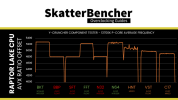Anyone have any tips for undervolting a modern Intel CPU? I want to keep stock clocks and lower power/temps. I don't have a watercooler (seen first hand what happens when they leak) and my Deepcool AK400 is just shy of being able to maintain 5.1GHz under max load.
I have a 13600K and Gigabyte Z790 UD AC. I went into the UEFI and set voltage offset to Legacy mode and then went -0.025V on the core and -0.025V on the ring. This did drop package power and temps a bit but I'm not sure if there's a better way or how low I'm likely to be able to go on a setup like this.
I have a 13600K and Gigabyte Z790 UD AC. I went into the UEFI and set voltage offset to Legacy mode and then went -0.025V on the core and -0.025V on the ring. This did drop package power and temps a bit but I'm not sure if there's a better way or how low I'm likely to be able to go on a setup like this.



